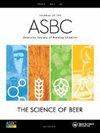Mouthfeel of Beer: Development of Tribology Method and Correlation with Sensory Data from an Online Database
IF 1.8
4区 农林科学
Q4 BIOTECHNOLOGY & APPLIED MICROBIOLOGY
Journal of the American Society of Brewing Chemists
Pub Date : 2021-07-26
DOI:10.1080/03610470.2021.1938430
引用次数: 7
Abstract
Abstract Soft tribology has recently gained momentum as a technique to measure friction properties of food that can be correlated to mouthfeel. The mouthfeel of beer is an important driver of acceptance and liking of consumers, and especially non-alcoholic beers are often rated poorly in terms of palate fullness. In the present work, frictional parameters of ten beers (five alcoholic and their non-alcoholic counterpart) were measured, and a range of variables was extracted and subjected to dimension reduction analysis (Principal Component Analysis, clustering, and correlation analysis). Sensory data consisting of a numeric mouthfeel rating and written reviews from an online beer-rating website (www.ratebeer.com) were compiled, transformed, and correlated with the tribology data. Based on frictional parameters of the beers, clear differences were observed between alcoholic and non-alcoholic beers, as well as those beers with high or low mouthfeel rating. Text-mining and clustering of the written reviews led to the development of seven overall sensory descriptors ("watery", "smooth", "thick", "bitter", "foam", "astringent", and "sour") related to mouthfeel. Frictional parameters related to the static, boundary and beginning of the mixed regime were correlated with "watery", "smooth", and "thick", while "bitter", "foam", "astringent", and "sour" were represented later in the mixed regime. These results are significant in two ways; firstly, they indicate that online beer reviews represent a valuable resource when gathering large amounts of sensory data, and secondly, they demonstrate tribology as a tool to instrumentally determine important mouthfeel parameters of beer.啤酒口:摩擦学方法的发展及其与在线数据库中感官数据的相关性
摘要软摩擦学作为一种测量与口感相关的食物摩擦特性的技术,最近获得了发展。啤酒的口感是消费者接受和喜爱的重要驱动因素,尤其是不含酒精的啤酒,在口感饱满度方面往往评价不佳。在本工作中,测量了十种啤酒(五种含酒精的啤酒及其非含酒精的对应啤酒)的摩擦参数,提取了一系列变量,并进行了降维分析(主成分分析、聚类和相关性分析)。对由数字口感评级和在线啤酒评级网站(www.ratebeer.com)的书面评论组成的感官数据进行了汇编、转换,并将其与摩擦学数据相关联。根据啤酒的摩擦参数,在含酒精和不含酒精的啤酒以及口感等级高或低的啤酒之间观察到明显的差异。对书面评论的文本挖掘和聚类导致了与口感相关的七个整体感官描述符(“水”、“滑”、“稠”、“苦”、“泡沫”、“涩”和“酸”)的发展。与静态、边界和混合状态开始相关的摩擦参数与“水”、“光滑”和“粘稠”相关,而“苦”、“泡沫”、“涩”和“酸”在混合状态后期出现。这些结果在两个方面具有重要意义;首先,他们表明在线啤酒评论在收集大量感官数据时是一种有价值的资源,其次,他们证明摩擦学是一种工具,可以通过仪器确定啤酒的重要口感参数。
本文章由计算机程序翻译,如有差异,请以英文原文为准。
求助全文
约1分钟内获得全文
求助全文
来源期刊

Journal of the American Society of Brewing Chemists
工程技术-生物工程与应用微生物
CiteScore
4.00
自引率
20.00%
发文量
41
审稿时长
3 months
期刊介绍:
The Journal of the American Society of Brewing Chemists publishes scientific papers, review articles, and technical reports pertaining to the chemistry, microbiology, and technology of brewing and distilling, as well as the analytical techniques used in the malting, brewing, and distilling industries.
 求助内容:
求助内容: 应助结果提醒方式:
应助结果提醒方式:


